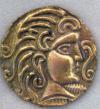When Asteroids Collide, Comets Are Born

Comets such as the Halley or the Hale-Bopp are small objects travelling through the solar system in long elliptical orbits. Their characteristic tail appears every time they get close to the Sun, when heat and solar winds combine to melt their frozen core surface.
The asteroids circling the Sun on the Main Belt between Mars and Jupiter do not have tails. Their regular orbit keeps them closer to the Sun at all times, which means that any ice they might have had on the surface evaporated a long time ago.
So says conventional wisdom.
But astronomers have recently discovered at least seven examples of asteroids with a comet-like tail within the main belt. How does that work? Where does the tail come from?
These strange objects are called main-belt comets and they are thought to be the remnants of a larger body smashed to pieces by a recent impact. One way to prove the theory is to look for examples of an asteroid family that shares their origin with a main-belt comet.
Building an asteroid family tree
Serbian astronomer Bojan Novakovic, from the University of Belgrade, is working on this problem with colleagues Henry Hsieh and Alberto Cellino. The team focused on the P/2006 VW139 main-belt comet and their goal was to see if it could be assigned to a family of asteroids.
First described as an asteroid, it was reclassified as a main-belt comet in 2011 when astronomers working on the Pan-STARRS1 survey telescope in Hawaii discovered its tail.
P/2006 VW139 is special as one of the only seven known examples of main-belt comets, but finding other members of its family among hundreds of thousands of possible candidates is not an easy task.
Bojan started his search at the AstDys database, a catalogue of 398,841 asteroids, using the hierarchical clustering method and the cut-off distance parameter to sort through the candidates. This narrowed down the possibilities to 24 asteroids.
The next step was to refine the group by looking at the detailed orbital characteristics of these 24 asteroids. For this task, Bojan used a method called backward integration, “which can be used to distinguish real family members from interlopers,” he explains.
To investigate the orbital characteristics of potential family members Bojan needed to go through a large number of calculations, which were “computationally expensive and would take months to be done on a typical PC,” he adds.
The solution to this problem was to use grid computing. “In particular for this work we used infrastructure of Academic and Educational Grid Initiative of Serbia,” Bojan says.
After looking at the complete orbital histories of 24 objects with the help of grid computing, Bojan was able to reduce the P/2006 VW139 family to just 11 members.
P/2006 VW139 and its young family of 11
The most important conclusion of Bojan’s research, published in the Monthly Notices of the Royal Astronomical Society, is that P/2006 VW139 and its 11 partners are part of a real asteroid family formed about 7.5 million years ago. “[Asteroid] families are consider to be young if they are less than about 10 million years old,” he explains.
This suggests that 7.5 million years ago, a large asteroid crashed with another object and disintegrated into 11 smaller pieces: P/2006 VW139 and its 10 family members. P/2006 VW139 is special because it inherited the deeply buried ice of the parent asteroid. It’s this ice that vaporises producing the characteristic tail of a comet.
“The fact that ice still exists close to the surface of P/2006 VW139 means that its surface is relatively young,” says Bojan. This means P/2006 VW139 and its siblings were formed long after the asteroid belt supporting the theory that main-belt comets are born in collision events within the asteroid belt and not through some other means.
Contacts and sources:
Citation: B. Novakovic et al. (2012). P/2006 VW139: A Main-Belt Comet Born in an Asteroid Collision? MNRAS 424, 1432-1441 (abstract: http://arxiv.org/abs/1205.4949)
Anyone can join.
Anyone can contribute.
Anyone can become informed about their world.
"United We Stand" Click Here To Create Your Personal Citizen Journalist Account Today, Be Sure To Invite Your Friends.
Before It’s News® is a community of individuals who report on what’s going on around them, from all around the world. Anyone can join. Anyone can contribute. Anyone can become informed about their world. "United We Stand" Click Here To Create Your Personal Citizen Journalist Account Today, Be Sure To Invite Your Friends.
LION'S MANE PRODUCT
Try Our Lion’s Mane WHOLE MIND Nootropic Blend 60 Capsules
Mushrooms are having a moment. One fabulous fungus in particular, lion’s mane, may help improve memory, depression and anxiety symptoms. They are also an excellent source of nutrients that show promise as a therapy for dementia, and other neurodegenerative diseases. If you’re living with anxiety or depression, you may be curious about all the therapy options out there — including the natural ones.Our Lion’s Mane WHOLE MIND Nootropic Blend has been formulated to utilize the potency of Lion’s mane but also include the benefits of four other Highly Beneficial Mushrooms. Synergistically, they work together to Build your health through improving cognitive function and immunity regardless of your age. Our Nootropic not only improves your Cognitive Function and Activates your Immune System, but it benefits growth of Essential Gut Flora, further enhancing your Vitality.
Our Formula includes: Lion’s Mane Mushrooms which Increase Brain Power through nerve growth, lessen anxiety, reduce depression, and improve concentration. Its an excellent adaptogen, promotes sleep and improves immunity. Shiitake Mushrooms which Fight cancer cells and infectious disease, boost the immune system, promotes brain function, and serves as a source of B vitamins. Maitake Mushrooms which regulate blood sugar levels of diabetics, reduce hypertension and boosts the immune system. Reishi Mushrooms which Fight inflammation, liver disease, fatigue, tumor growth and cancer. They Improve skin disorders and soothes digestive problems, stomach ulcers and leaky gut syndrome. Chaga Mushrooms which have anti-aging effects, boost immune function, improve stamina and athletic performance, even act as a natural aphrodisiac, fighting diabetes and improving liver function. Try Our Lion’s Mane WHOLE MIND Nootropic Blend 60 Capsules Today. Be 100% Satisfied or Receive a Full Money Back Guarantee. Order Yours Today by Following This Link.






